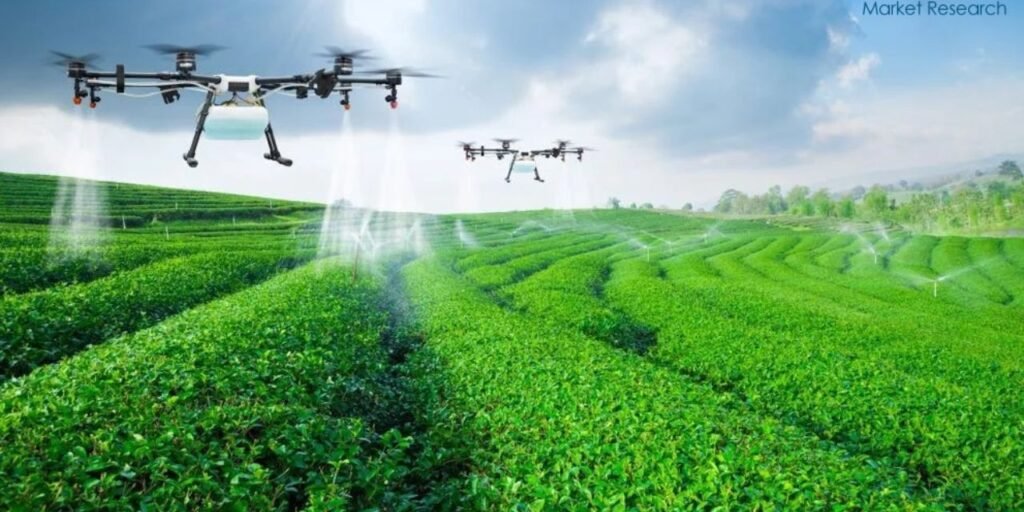
How Agriculture Drones Are Transforming Precision Agriculture for Higher Yields and Sustainability
In recent years, agriculture has witnessed a technological revolution, with drones emerging as a game-changing tool for farmers worldwide. These unmanned aerial vehicles (UAVs) have transformed traditional farming practices, enabling precision agriculture, optimizing resource use, and ensuring sustainable farming methods.
The agriculture drone market is anticipated to experience substantial growth, expanding from an estimated US$ 3.14 billion in 2025 to approximately US$ 11.21 billion by 2032. This growth trajectory is driven by a robust CAGR of 19.9% during the forecast period from 2025 to 2032, reflecting the increasing adoption of drone technology in modern farming practices.
The Rise of Agriculture Drones in Precision Farming
Precision agriculture aims to maximize crop yields while minimizing inputs such as water, fertilizers, and pesticides. Agriculture drones play a crucial role in achieving this goal by offering real-time data collection, monitoring crop health, and improving farm management strategies. With high-resolution cameras, multispectral sensors, and artificial intelligence capabilities these drones provide actionable insights that help farmers make informed decisions.
According to Fairfield Market Research, the agriculture drone market is projected to expand rapidly due to rising global food demand and the need for efficient farming solutions. Government initiatives promoting smart agriculture, coupled with advancements in drone technology, are further driving this market’s growth.
Key Applications of Agriculture Drones
Crop Monitoring and Health Assessment Drones equipped with multispectral imaging sensors can assess crop health by detecting variations in plant colour and chlorophyll levels. This enables farmers to identify diseased or stressed crops early, preventing potential yield losses. By addressing issues promptly, farmers can implement targeted treatments, reducing overall chemical usage.
Soil and Field Analysis Drones help in soil health assessment by capturing data on moisture levels, nutrient content, and temperature variations. This information allows farmers to customize irrigation and fertilization strategies, enhancing soil productivity and reducing wastage.
Planting and Seeding Advanced drones can perform precision seeding, reducing manual labour and ensuring uniform seed distribution. This method enhances germination rates while optimizing seed utilization, making it a cost-effective solution for large-scale farming operations.
Spraying Pesticides and Fertilizers Traditional pesticide spraying methods can lead to overuse and environmental contamination. Agriculture drones with precision spraying technology can distribute fertilizers and pesticides accurately, reducing chemical runoff and ensuring better crop protection. This method also minimizes human exposure to harmful chemicals, improving worker safety.
Irrigation Management Drones equipped with thermal imaging cameras detect variations in soil moisture levels, enabling farmers to optimize irrigation schedules. This targeted approach conserves water resources and ensures crops receive adequate hydration, particularly in drought-prone regions.
Livestock Monitoring Beyond crops, drones are also used in livestock farming for monitoring herd movements, detecting sick animals, and ensuring better pasture management. This helps farmers reduce losses and improve animal welfare.
Market Trends Driving Growth
Advancements in Drone Technology Technological innovations such as artificial intelligence, machine learning, and improved battery life are enhancing drone capabilities. Autonomous flight modes, AI-driven analytics, and real-time data processing have made drones more efficient and accessible to farmers worldwide.
Government Initiatives and Subsidies Governments across various countries are actively supporting precision agriculture through subsidies and policy frameworks. Incentives for adopting smart farming technologies, including drones, are encouraging small and large-scale farmers to invest in this technology.
Growing Interest in Sustainable As environmental sustainability and climate change issues gain traction, farmers are increasingly turning to agricultural drones as their go-to option for environmentally responsible farming practices. Sustainable agricultural methods include better irrigation, less chemical use, and precision spraying.
Growing Small and Medium-Sized Farmer Adoption Due to their expensive cost, drone usage was previously restricted to large-scale farms. However, the industry is expanding since small and medium-sized farms can now afford this technology thanks to declining drone pricing and rental services.
Challenges and Future Outlook
Despite their advantages, agriculture drones face challenges such as regulatory restrictions, high initial investment costs, and the need for skilled operators. However, ongoing research and development efforts aim to make drones more cost-effective, user-friendly, and compliant with global regulations.
They predict a robust growth trajectory for the agriculture drone market as more farmers recognize the benefits of drone technology. The integration of artificial intelligence, automation, and big data analytics will further enhance drone capabilities, paving the way for a more efficient and sustainable agricultural future.
Conclusion
Agriculture drones are revolutionizing modern farming by enabling precision agriculture, optimizing resource utilization, and promoting sustainability. With technological advancements and increasing government support, the agriculture drone market is poised for substantial growth. As farmers embrace drone technology, the future of agriculture looks more productive, efficient, and environmentally friendly.
